Losing important files on your PC can happen to anyone and make crucial files disappear in seconds. While there is a Windows solution to recover lost data that works through command lines, and can be hard for new users to operate. Third-party recovery software provides better user interfaces and broader file support.
In this guide, we’ll compare Windows File Recovery with a leading third-party tool to assess their usability and value. It will also help you decide which option best fits their data recovery needs without compromising safety or convenience.
Try Recoverit to Perform Windows File Recovery

In this article
Part 1. What Is Windows File Recovery and How Does It Work?
Microsoft came up with Windows File Recovery software to assist users in recovering deleted files in various storage gadgets, including hard drives and memory cards. It provides different recovery options depending on the context of data loss, e.g., accidental deletion or disk corruption. Even though it does not have a graphical interface, Windows File Recovery is unique in terms of its security and free availability to everybody.
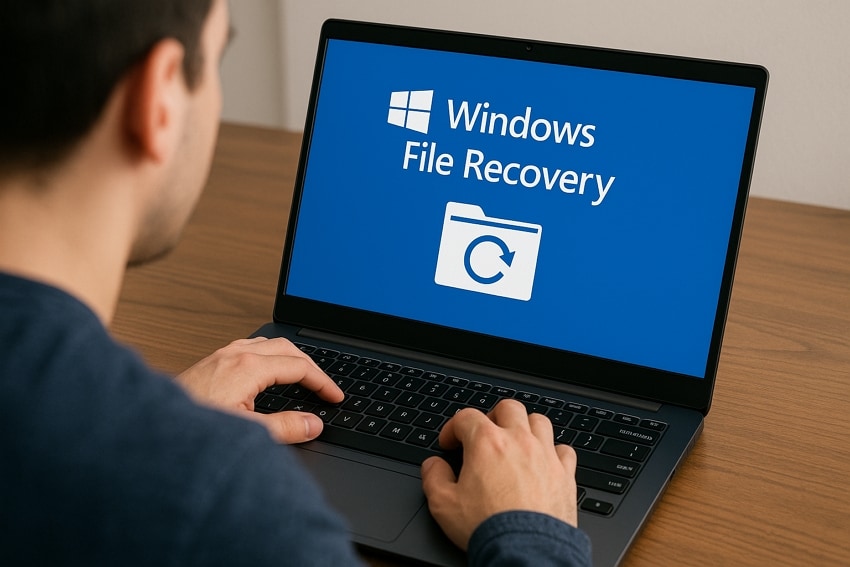
Supported File Types and Drive Formats
Windows File Recovery supports a broad range of file types and drive formats, which makes it versatile for different recovery scenarios.
Supported File Types
The tool can recover most common data formats, including documents, images, videos, and archives. Supported file types include DOCX, XLSX, PPTX, PDF, TXT, JPG, PNG, GIF, BMP, MP3, MP4, ZIP, and MPEG.
Drive Formats Supported
Let’s take a closer look at the drive formats supported for file recovery.
- NTFS: Commonly used for modern Windows drives (HDDs and SSDs); supports the Regular, Segment, and Extensive modes for deep recovery.
- FAT and exFAT: Used mainly on USB drives and SD cards; only support recovery through Signature mode.
- ReFS: Designed for servers and large storage volumes; basic recovery is supported, but without folder structure restoration.
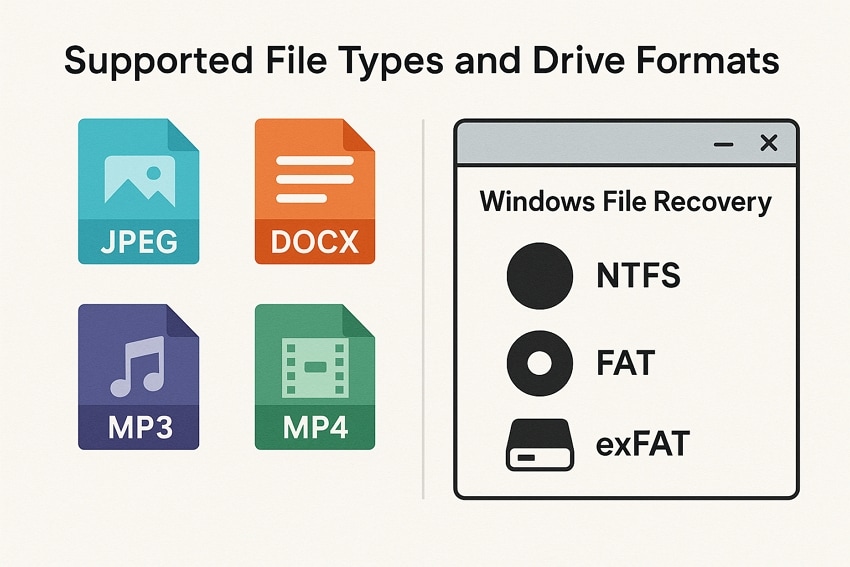
Scanning Modes
Having discussed the file types and drive formats Windows File Recovery tool supports, let’s shed some light on its scanning mode.
- Regular Mode: Regular Mode is ideal for recovering recently deleted files from healthy NTFS drives. It uses the Master File Table (MFT) to restore files with their original names and folder structure.
- Extensive Mode: Extensive Mode performs a deep scan for formatted or corrupted data on NTFS and other supported drives. It retrieves files by using signatures, though filenames and folders may not be preserved.
- Segment and Signature Modes (Advanced): The segment mode locates deleted files on NTFS volumes using record segments when the MFT is unavailable. Whereas the signature mode identifies files by their headers and works across all file systems, including FAT and exFAT.
Part 2. Key Features Highlighted in Windows File Recovery Review
After discussing the scanning modes of Windows File Recovery, let’s move on to the highlighted features that this tool offers.
- Pattern-Based File Search: Allows recovery of files using wildcards and text strings to locate specific or unknown file names.
- Folder Targeted Recover: Users can limit scans to specific directories to reduce scanning time and improve search accuracy.
- Multi-Type Search in One Command: This tool supports the recovery of multiple file types by adding repeated n/ filters commands within a single scan.
- Auto Recovery Folder: Recovered files are automatically sorted in a folder called Recover on the destination drive.
- Saving Requirement: Saves recovered files in a different drive other than the location of the original file to avoid overwriting.
- Allows Wildcard and Text String Searching: Users can find files at a time when they only remember part of the file name through flexible search patterns.
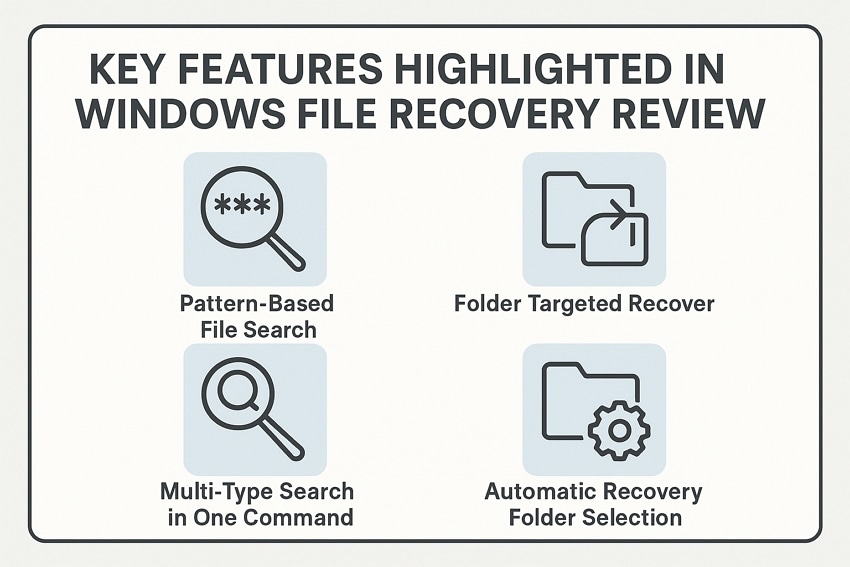
Part 3. Step-by-Step Guide: How to Use Windows File Recovery Effectively
Having been informed about the peculiarities of the Windows recovery tool, you might want to know how you can utilize this tool. Follow the steps below to see the procedure to recover deleted files on Windows from the C to the E drive with this tool:
- First, enter the command “winfr C: E: /n *.pdf” and press the “Enter” key. Change the file format, or do not specify a file format if you want to recover all files.
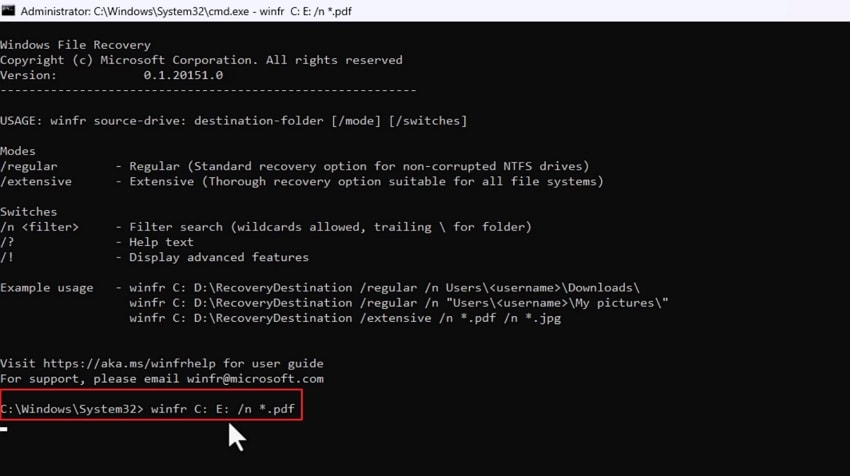
- It will ask you to confirm, which is done by pressing the “Y” key on your keyboard to start the scanning process.
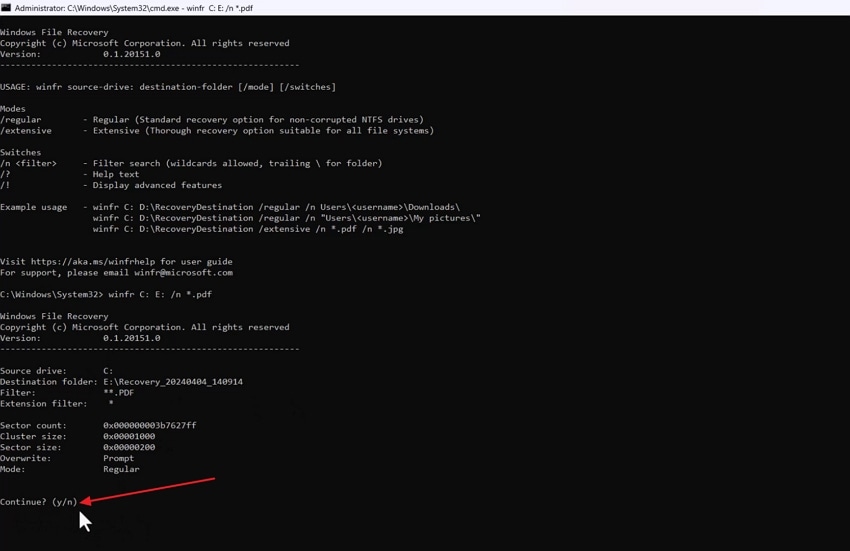
- Once the scanning is completed, the tool will ask you to view the recovered files. Press the “Y” key again and you’ll be directed towards the recovered file folder.

Recovery Results
In our testing of this tool, we observed that the way recovered files are saved differs between regular and extensive modes.
- This tool took around 12 minutes to scan a corrupted drive and recovered 750 image files out of 900 files.
- Regular mode completed the scanning process in less than 3 minutes, yet it just recovered recently deleted files.
- Windows File Recovery software worked best with the NTFS drive and restores files with original names preserved.
Part 4. Limitations Found in Windows File Recovery Review
While the tool can recover in certain situations, it has clear limitations as well. Check out the limitations users face while recovering files via this tool.
- Command-Line Interface Only: This tool comes with a command-line interface without any graphical elements. That makes it difficult to operate for users who prefer visual tools.
- Limited File System Support: Works best with the NTFS file system only to recover files. Lacks support for file systems like HFS+, ext4, or APFS.
- Lacks Full Disk Scan: Users can only scan individual partitions rather than entire physical drives. This restricts data recovery on systems with multiple hidden partitions.
- Weak Signature Mode: The signature mode recovery only identifies a restricted set of file formats. Many files remain unrecoverable if their extensions are unsupported.
- Risk of Command Errors: Minor syntax and path entry mistakes can stop the recovery process. Users get little guidance and no error-handling support from this tool.

Part 5. When to Use Windows File Recovery on Your PC: Use Cases
Having discussed the limitations users face while performing data recovery for Windows, let’s explore some use cases where this tool can be a lifesaver.
- Post Accidental Deletion: This tool can be used to recover deleted files in NTFS drives in case of accidental deletion of files in file directories and the Recycle Bin.
- Corrupted or Formatted Drives: The extensive mode assists in the recovery of data from the formatted or corrupted drives and deeply scans the drives in search of recoverable fragments.
- Data Lost After Windows Update: Data that has been lost after a system update can be retrieved by scanning the drive that has been affected.
- Retrieve Specific File Types or Folders: Restores selected file types and entire folders by running targeted commands for precise recovery.
- Data Wipe-Out After Virus Attack: This tool helps restore unencrypted file data that is wiped out after a malware or virus attack on a system.

Part 6. Comparing Windows File Recovery with Recoverit for Better Results
Before you decide which tool to use for data recovery, let’s compare Windows File Recovery with Recoverit to understand which tool provides scalable outcomes.
| Features | Windows File Recovery | Wondershare Recoverit |
|---|---|---|
| 📌Platform Support | Windows 10 & 11 | Windows 7–11, macOS 10.11+, incl. Apple Silicon |
| 📛User Interface | Command-line only | Modern graphical interface |
| 📚Supported File Types | <50; basic docs, images, videos | 1,000+ formats; RAW, MP4, MOV, Office, compressed, etc. |
| 📇File Systems Supported | NTFS, FAT, exFAT, ReFS | NTFS, FAT32, exFAT, ReFS, ext4, BTRFS |
| 💾Supported Devices | HDDs, SSDs, USB, SD cards | HDDs, SSDs, USB, SD cards, cameras, drones, RAID, NAS |
| 💽Disk Image & Clone | ❌ | Supports disk image creation and recovery |
| 📤Preview Files Before Recovery | ❌ | ✅ |
| 📈Advanced Recovery Functions | Basic recovery | Video/photo repair, system-crash rescue |
Which One Should You Choose for Data Recovery?
Following the comparison of Windows File Recovery software with a modern third-party tool, you may wonder which tool you should prefer. Follow the functions listed below to find out the points that you need to remember before downloading a tool.
- A tool that has a graphical user interface is a good choice in case you want a graphical and easy-to-use interface as opposed to the command line.
- Previews that are available in tools prior to saving files assist in saving only the files that are required.
- Select an option that supports a wide range of file formats and storage devices to maximize recovery chances.
- Advanced filtering and deep scanning narrow down the search process and improve recovery success in complex scenarios.
- Look for multi-platform compatibility if you use both Windows and macOS to recover data, regardless of the operating system.
If you’ve used the Windows File Recovery tool and failed to recover files, you are not alone. A significant number of users prefer third-party data recovery programs that offer a graphical interface with an advanced recovery solution. This is where Recoverit comes in to help you retrieve lost data and system files with advanced recovery tools. Its deep scanning modes restore a wide range of files in less time.
Unlike other recovery tools, it supports more than 1000 types of files and can recover from 1 M+ storage devices. Recoverit also repairs corrupted data and documents with extreme precision and offers over 35 patented technologies. You can pause or stop the scanning process once you see your deleted file. Users can choose a specific directory, and the tool performs an extensive scan across the selected disk.
Key Features
- Advanced Search Filters: Provides multiple search filters, including file size or file type, to narrow down the search results.
- Preview Before Saving: Allows users to see the scanned results in the Preview window before saving the recovered files.
- Large Files Recover: Users can recover files of up to 100MB in size without requiring an upgrade to the premium version.
Guide to Recover Lost or Deleted Files With Wondershare Recoverit
Having discussed the features of Recoverit, follow the steps below to recover deleted files on Windows with this tool:
- Choose a Location to Start The Scanning Process
First off, press the “Hard Drives and Location” tab from the left side menu. Select a directory where the lost file was saved to start the scanning process.

- Add Filters During the Deep Scanning Procedure
Now, hit the “Filter” icon to view a drop-down menu. Here, set filters like “File Type” and “File Size” to speed up the search process.
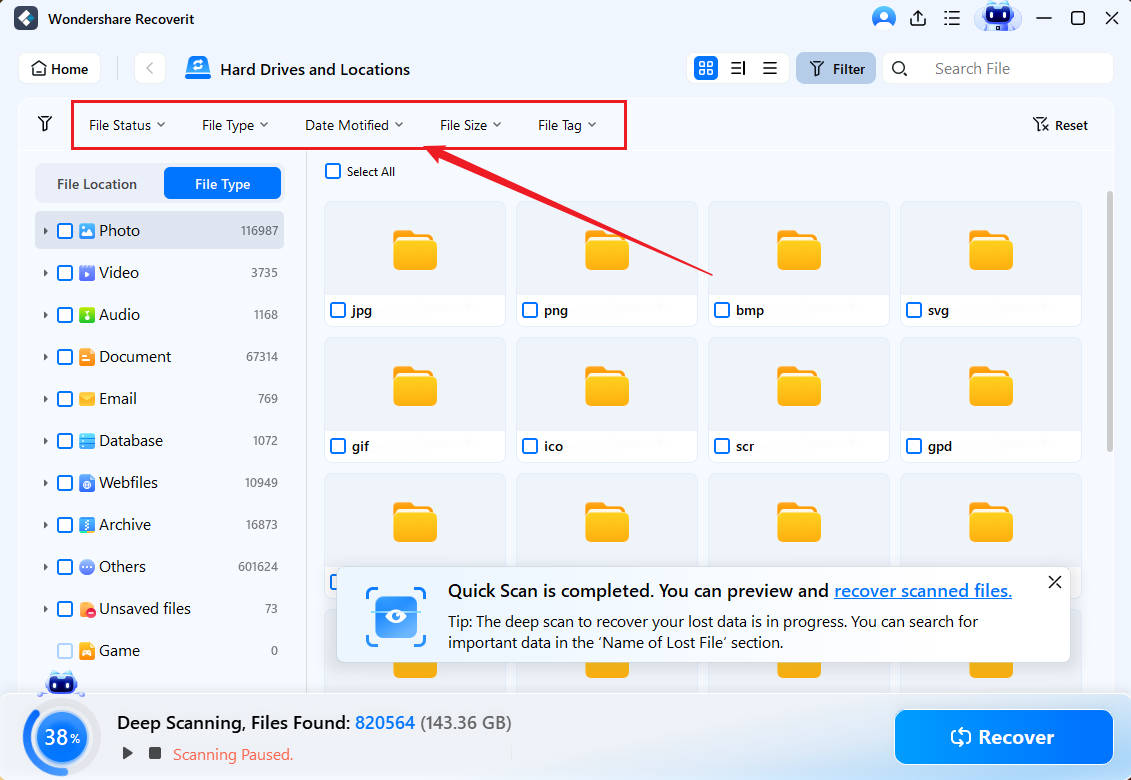
- Preview The Scanned Files Before Exporting
Once the lost file appears in the “File Path” panel, view it on the “Preview” screen. If the scanned file seems correct, press the “Recover” button to save it.
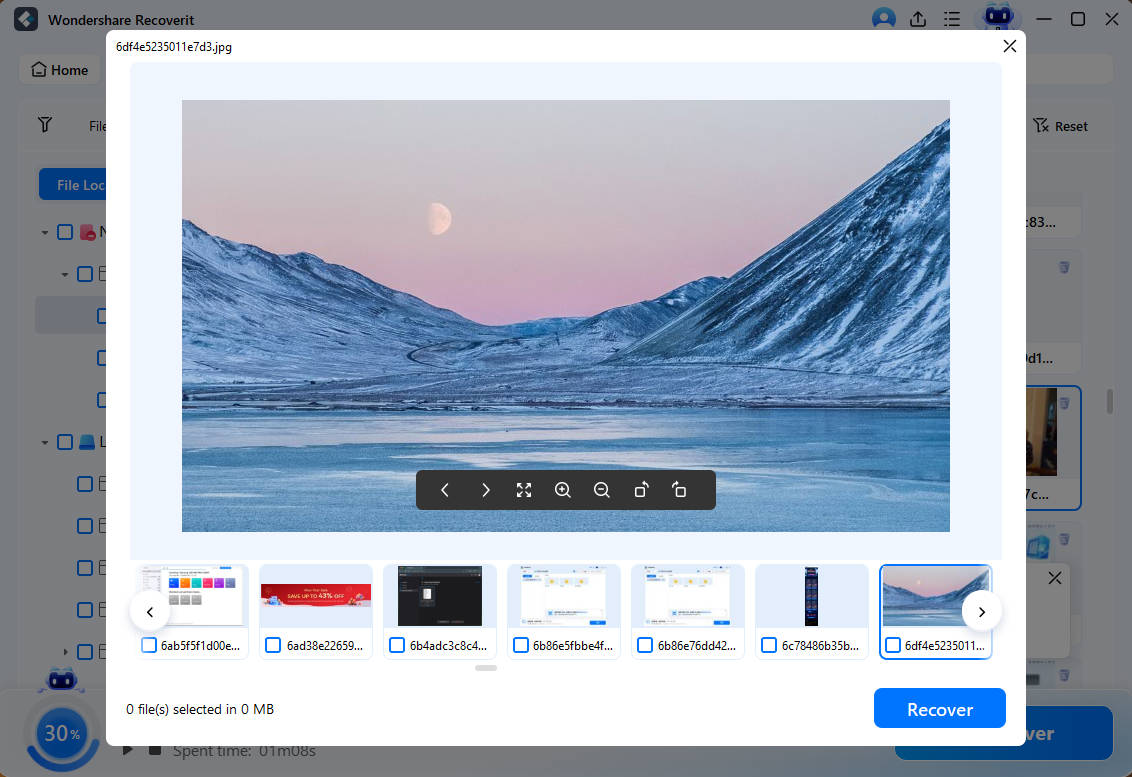
Conclusion
To conclude, Windows File Recovery offers a basic, yet scalable solution for recovering deleted files, particularly from NTFS drives. However, its command line interface and limited data recovery file system support make it difficult to use and restrict flexible recovery options for average users. If you aim to use another recovery tool with a graphical interface and advanced recovery modes, use Recoverit to store deleted files.
FAQ
-
1. How does Windows File Recovery handle corrupted partitions?
Windows File Recovery software can scan corrupted partitions using its Extensive mode, but it may not always restore the full folder structure. Such tools as Wondershare Recoverit have improved solutions to corrupted partitions and recovery without compromising quality. -
2. Can Windows File Recovery recover files from encrypted drives?
It fails to allow one to recover encrypted or BitLocker-protected drives. Before the data can be made available to the system, the data must first be decrypted. -
3. Is there any risk of data loss when using Windows File Recovery?
When commands are wrongly typed, there is a chance of losing or destroying files. Data loss risks can be reduced by proper care and the use of an alternate destination drive. -
4. Can Windows File Recovery recover files from external hard drives or flash drives?
Yes, it supports recovery of USB drives, external hard disks of NTFS, FAT, exFAT, as well as ReFS, and is limited in modes by the file system.
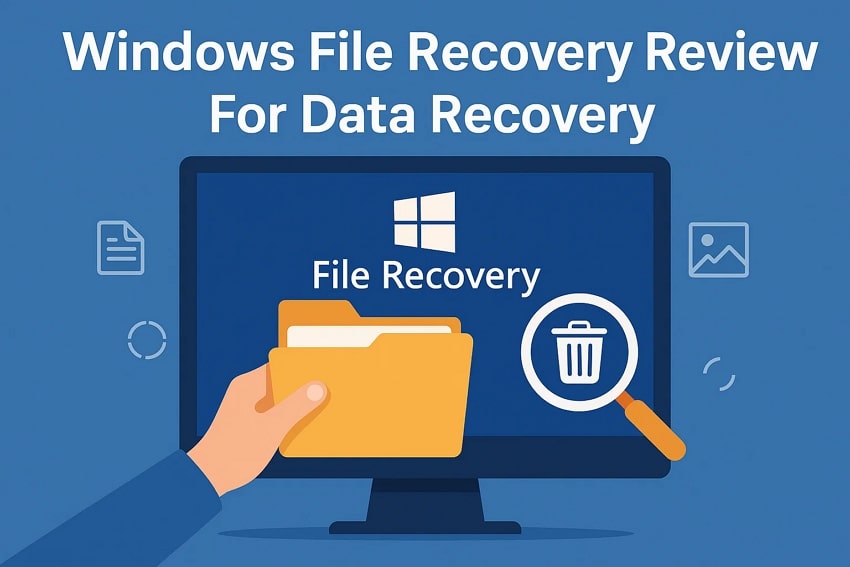



 ChatGPT
ChatGPT
 Perplexity
Perplexity
 Google AI Mode
Google AI Mode
 Grok
Grok























